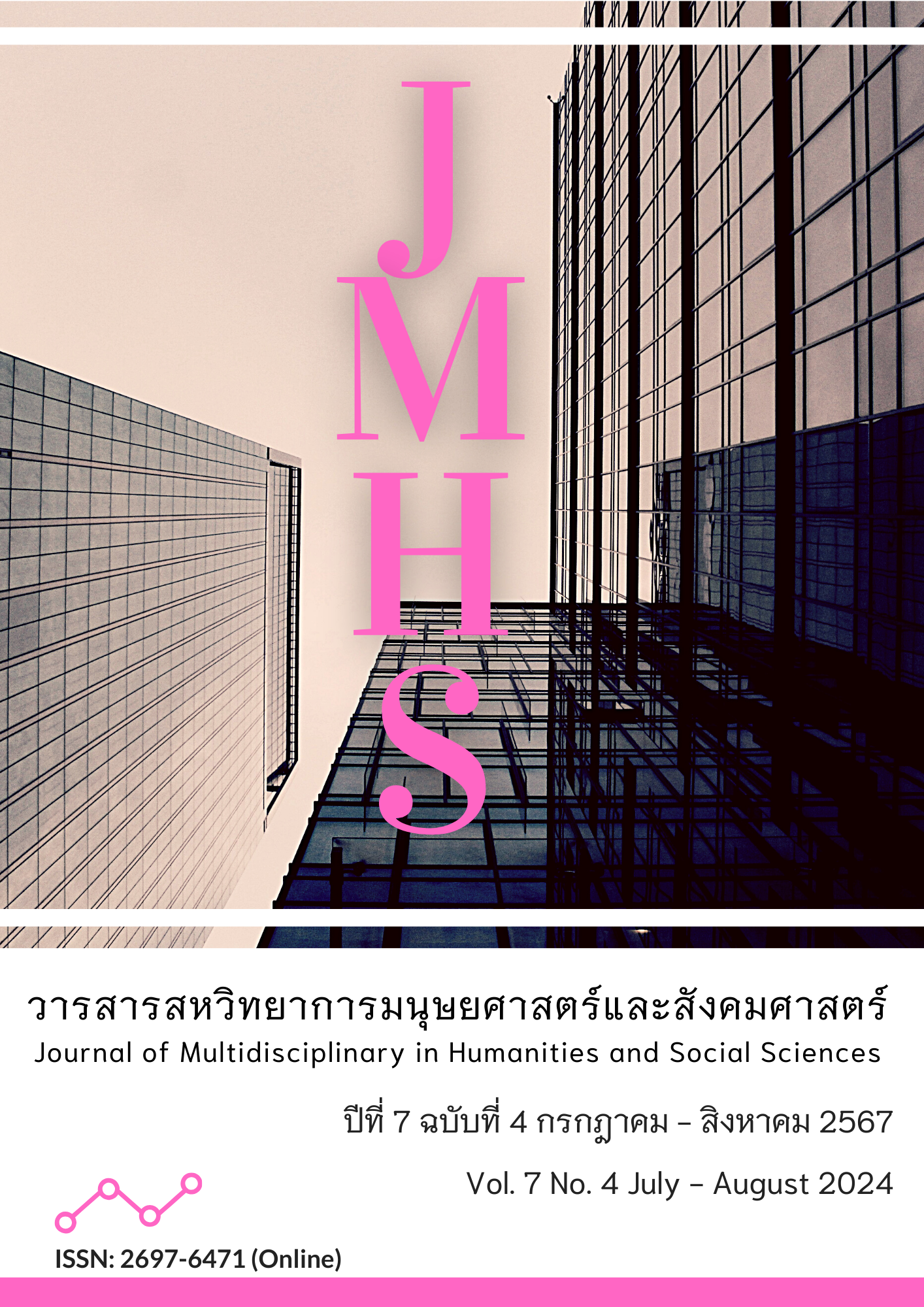Causal Factors Influencing Loyalty to Buy Skincare on Application Tiktok Shop of Consumers in Bangkok and Its Vicinity
Main Article Content
Abstract
This article aimed to 1) empirically study the causal relationship model of customer loyalty when purchasing skin care through the TikTok Shop application in Bangkok and its vicinity; and 2) study the causal factors that influence customer loyalty when purchasing skin care through the TikTok shopping application in Bangkok and its vicinity. The research format was quantitative research. The tools used to collect data were online questionnaires. The sample group consisted of 200 people who had previously purchased skin care through the TikTok Shop application and lived in Bangkok and the surrounding areas. Statistics used to analyze the data include frequency, percentage, confirmatory factor analysis, and structural equation models.
It was found that the developed causal relationship model consists of four aspects: 1) service quality; 2) organizational reputation; 3) trust in the organization; and 4) customer loyalty. This was in good agreement with the empirical data, considering the CMIN/df value = 1.55, the GFI value = 0.94, the AGFI value = 0.91, the SRMR value = 0.03, the RMSEA value = 0.05, and the prediction coefficient = 0.62, indicating that the variables in the model can explain the variance in customer loyalty at 62 percent. It was found that trust and organizational reputation have a direct effect on customer loyalty, respectively. Service quality has an indirect influence on customer loyalty via trust. To build loyalty among skincare customers who purchase through TikTok channels, entrepreneurs should build customer trust in the organization's reputation and service quality.
Article Details

This work is licensed under a Creative Commons Attribution-NonCommercial-NoDerivatives 4.0 International License.
Views and opinions appearing in the Journal it is the responsibility of the author of the article, and does not constitute the view and responsibility of the editorial team.
References
เกศมณี เลิศกิจจา. (2566). คนไทยสวยทุกยุค! หนุนตลาดเครื่องสำอางโตแกร่ง กูรูแนะแบรนด์ไทยเร่งปรับตัว. สืบค้นเมื่อ 18 กุมภาพันธ์ 2567, จาก https://www.bangkokbiznews.com/business/business/1089181
ชวิน จุลาเกตุโพธิชัย และ ชัยฤกษ์ แก้วพรหมมาลย์. (2564). ปจจัยที่ส่งผลต่อความภักดีตราสินค้าร้านวิคตอรี่เบเกอรี่ของลูกค้าในเขตกรุงเทพมหานครและปริมณฑล.วารสารสมาคมนักวิจัย, สาขามนุษยศาสตร์และสังคมศาสตร์, 26(3), 140-155. สืบค้นจาก https://so04.tci-thaijo.org/index.php/jar/article/view/250158/171072
ชนิดา ศักดิ์สิริโกศล. (2566). อิทธิพลของฟิลเตอร์ประกอบการจัดแสงที่มีผลต่อโทนผิวเพื่อใช้ในการผลิตภาพถ่ายโฆษณาสกินแคร์. วารสารนวัตกรรมสื่อและการสื่อสาร, มหาวิทยาลัยเทคโนโลยีราชมงคลธัญบุรี, 2(1), 90-109. สืบค้นจาก https://so10.tci-thaijo.org/index.php/jimc/article/view/708/510
ณัฐพล ใยไพโรจน์. (2563). Digital Marketing Concept & Case Study ฉบับรับมือ New Normal หลัง COVID-19. (พิมพ์ครั้งที่ 7). นนทบุรี: ไอดีซี.
ทัศนา ประวิเศษ และ ธนาลัย สุคนธ์พันธุ์. (2563). TRY IT ON: แอปพลิเคชันห้องลองเสื้อผ้าออนไลน์ผ่านโทรศัพท์มือถือ. วารสารวิชาการวิทยาศาสตร์และเทคโนโลยีมหาวิทยาลัยราชภัฏสงขลา, 1(2),59-67. สืบค้นจาก https://ph02.tci-thaijo.org/index.php/SciAndTechSkru/article /view/244002/165459
บุญชม ศรีสะอาด. (2554). หลักการวิจัยเบื้องต้น. (พิมพ์ครั้งที่ 9). กรุงเทพฯ: สุวีริยาสาส์น.
เพชรรัตน์ อนันต์เศรษฐการ และ เสาวนีย์ มะหะพรหม. (2564). ปัจจัยส่วนประสมทางการตลาดที่มีผลต่อพฤติกรรมการตัดสินใจซื้อสกินแคร์ผ่านสังคมออนไลน์ (Instagram) ของคนรุ่นใหม่กลุ่มเจเนอเรชั่นวาย ในจังหวัดกาญจนบุรี. วารสารวิทยาการจัดการ มหาวิทยาลัยราชภัฎนครปฐม, 9(1), 413-428. สืบค้นจาก https://so03.tci-thaijo.org/index.php/JMSNPRU/article/view/261958/174522
ภารวี พล้าโน๊ต, สิริชัย ดีเลิศ และ ชลธิศ ดาราวงษ์. (2565). การตลาดเชิงอารมณ์และประสบการณ์ออนไลน์ที่มีอิทธิพลต่อความไว้วางใจและความภักดีต่อตราสินค้าของกลุ่มแฟนคลับชาวไทย ผ่านตลาดกลางพาณิชย์อิเล็กทรอนิกส์ที่ใช้ศิลปินเกาหลีใต้. วารสารวิชาการศรีปทุม ชลบุรี, 19(2), 188-198. สืบค้นจาก https://so05.tci-thaijo.org/index.php/SPUCJ/article/view/259623/176405
มณีกัญญา นากามัทสึ, อภิรัช ประชาสุภาพ, ชยานนท์ เชาวน์วุฒิกุล และ ปรียากมล มีอยู่เต็ม. (2566). การสร้างมูลค่าเพิ่มในผลิตภัณฑ์ครีมบำรุงผิวจากขี้ผึ้งและไขมะพร้าวรูปครีมสติ๊ก. วารสารมนุษยศาสตร์และสังคมศาสตร์ มหาวิทยาลัยเอเชียอาคเนย์, 7(1), 1-17. สืบค้นจาก https://so05.tci-thaijo.org/index.php/saujournalssh/article/view/264892/178277
มหัสธวิน ใจจิต. (2560). ปัจจัยที่มีความสัมพันธ์กับความภักดีของผู้บริโภคต่อร้านค้าปลีกวัสดุก่อสร้างสมัยใหม่ (Modern trade) ในเขตกรุงเทพมหานครและปริมณฑล. วารสารปัญญาวิวัฒน์, 9(2), 1-11. สืบค้นจาก https://so05.tci-thaijo.org/index.php/pimjournal/article/view/97817/76209
รัชชานนท์ ชัยเจริญ และ ประพล เปรมทองสุข. (2566). อิทธิพลของความปลอดภัยในการซื้อสินค้าออนไลน์และคุณภาพของสินค้าที่มีต่อความไว้วางใจและความจงรักภักดีของผู้ซื้อสินค้าออนไลน์. วารสารนวัตกรรมการจัดการศึกษาและการวิจัย, 5(2), 291-304. สืบค้นจาก https://so02.tci-thaijo.org/index.php/jemri/article/view/259087/175601
วรรณพร โตงาม และ ปรารถนา ปรารถนาดี. (2566). ปัจจัยที่ส่งผลต่อพฤติกรรมการซื้อสินค้าผ่านแอปพลิเคชัน TikTok Shop ของผู้บริโภคในเขตกรุงเทพมหานครและปริมณฑล. Procedia of Multidisciplinary Research, 1(3), 1-10. สืบค้นจาก https://so09.tci-thaijo.org/index.php/ PMR/article/view/2062/1079
วสุธิดา นุริตมนต์. (2564). การรับรู้คุณภาพผลิตภัณฑ์และคุณภาพการบริการที่มีอิทธิพลต่อการใช้บริการซ้ำร้านอาหารญี่ปุ่น. วารสารวิชาการและวิจัย, 11(3), 11-23. สืบค้นจาก https://so04.tci-thaijo.org/index.php/neuarj/article/view/248823/173848
วิลาสินี จงกลพืช และ มนัสสินี บุญมีศรีสง่า. (2563). คุณภาพการให้บริการในมุมมองของผู้บริโภคที่มีต่อธุรกิจเครื่องแก้ววิทยาศาสตร์กรณีศึกษาบริษัท เอ็น เค แลบอราทอรี (ประเทศไทย) จำกัด. วารสารการบริหารนิติบุคคลและนวัตกรรมท้องถิ่น, 7(6), 179-189.
วีระนันท์ คำนึงวุฒิ. (2562). อิทธิพลของปัจจัยด้านความพึงพอใจ ความไว้วางใจ และความภักดีในแบรนด์ของผู้บริโภคต่อความตั้งใจซื้อสินค้าตลาดออนไลน์. วารสารสถาบันเทคโนโลยีไทย-ญี่ปุ่น : บริหารธุรกิจและภาษา, 7(2), 88-99. สืบค้นจาก https://so06.tci-thaijo.org/index.php/TNIJournalBA/article/view/209498/157198
ศิริภัทร สิตไทย, ดวงฤดี ตันเจริญ และ ญานิน ตันวัฒนะ. (2566). ทัศนคติของผู้บริโภคที่มีต่อกลยุทธ์การสื่อสารทางการตลาดของผลิตภัณฑ์บำรุงผิวผ่านแอปพลิเคชันติ๊กต๊อก. วารสารนวตกรรมสังคมและเทคโนโลยีสื่อสารมวลชน, 6(2), 62-74. สืบค้นจาก https://so04.tci-thaijo.org/ index.php/JRBGS/article/view/266457/180355
ศุภิสรา กิจเจริญ, วสุธิดา นุริตมนต์ และ ณฐาพัชร์ วรพงศ์พัชร์. (2563). อิทธิพลของภาพลักษณ์องค์กรต่อความภักดีของผู้บริโภคที่ใช้บริการร้านกาแฟสตาร์บัคส์ในจังหวัดพระนครศรีอยุธยา. วารสารวิชาการและวิจัย มหาวิทยาลัยภาคตะวันออกเฉียงเหนือ, 10(3), 92-105. สืบค้นจาก https://so04.tci-thaijo.org/index.php/neuarj/article/view/244735/168561
สวารินทร์ อารยวรรณไชยา และ สวัสดิ์ วรรณรัตน์. (2564). ความสัมพันธ์เชิงสาเหตุของความภักดีต่อตราสินค้าผ่านคุณภาพการบริการและประสบการณ์ตราสินค้า กรณีศึกษาธุรกิจสนามฟุตบอลหญ้าเทียม จังหวัดนนทบุรี. วารสารวิชาการ มหาวิทยาลัยกรุงเทพ, 20(2), 47-61. สืบค้นจาก https://so01.tci-thaijo.org/index.php/buacademicreview/article/view/244407/169032
สิรินิธิ์ วิรยศิริ. (2566, 6 กรกฎาคม). “TikTok” เผยผลวิจัย 77% ของผู้บริโภคซื้อสินค้าจากคอนเทนต์ความบันเทิง. สืบค้นเมื่อ 18 กุมภาพันธ์ 2567, จาก https://www.dailynews.co.th/news/2507224/
สุมามาลย์ ปานคํา และ วรณัน จันทรอด. (2565). ปัจจัยเชิงสาเหตุที่มีอิทธิพลต่อความตั้งใจใช้บริการพนักงานทำความสะอาดบนแอปพลิเคชันซีคสเตอร์ ในกรุงเทพมหานครและปริมณฑล. วารสารศิลปการจัดการ, 6(3), 1096-1114.
อุบลวรรณ บุญบำรุง และ ณักษ์ กุลิสร์. (2564). ชื่อเสียง และความพึงพอใจ ที่ส่งผลต่อความภักดีต่อองค์กรของนิสิต วิทยาลัยนวัตกรรมสื่อสารสังคม มหาวิทยาลัยศรีนครินทรวิโรฒ. วารสารวิชาการนวัตกรรมสื่อสารสังคม, 10(1), 124-135.
Hair, J. F., Black, W. C., Babin, B. J., & Anderson, R. E. (2010). Multivariate data analysis. (7th ed.). Upper Saddle River, NJ: Prentice Hall.
Hair, J. F., Hult, G. T. M., Ringle, C. M., & Sarstedt, M. (2014). A Primer on Partial Least Squares Structural Equation Modeling (PLS-SEM). California, CA: Sage Publications.
Hoelter, J. W. (1983). The effects of role evaluation and commitment on identity salience. Social Psychology Quarterly, 46(2), 140–147. Retrieved from http://doi.org/10.2307/3033850
Hu, L.T., & Bentler, P. M. (1999). Cutoff criteria for fit indexes in covariance structure analysis: Conventional criteria versus new alternatives. Structural Equation Modeling, 6(1), 1–55. Retrieved from http://doi.org/10.1080/10705519909540118
Joreskog, K. G., & Sorbom, D. (1984). Advances in factor analysis and structural equation models. Lanham: Rowman & Littlefield Publishers.
Kline, R. B. (2011). Principles and practices of structural equation modeling. (3rd ed.), New York: The Guilford Press.
Mario, P., Zoran, M., & Sandra, P. (2013). Analysis of the effect of perceived service quality to the relationship quality on the business-to-business market. Journal of Contemporary Management, 18(2), 97-109.
Schreiber, J. B., Stage, F. K., King, J., Nora, A., & Barlow, E. A. (2006). Reporting structural equation modeling and confirmatory factor analysis results: A review. The Journal of Educational Research, 99(6), 323–337. https://doi.org/10.3200/JOER.99.6.323-338
Schumacker, R. E., & Lomax, R. G. (2004). A beginner's guide to structural equation modeling. (2nd ed.). Lawrence Erlbaum Associates Publishers.
Thompson, B. (2004). Exploratory and confirmatory factor analysis: Understanding concepts and applications. American Psychological Association. https://doi.org/10.1037/10694-000
Ullman, M. T. (2001). The declarative/procedural model of lexicon and grammar. Journal of Psycholinguistic Research, 30(1), 37–69. https://doi.org/10.1023/A:1005204207369
Wilson, N. (2020). The impact of service quality and corporate reputation toward loyalty in the Indonesian hospitality sector. Jurnal Muara Ilmu Ekonomi dan Bisnis, 4(1), 1-9. https://doi.org/10.24912/jmieb.v4i1.6925


